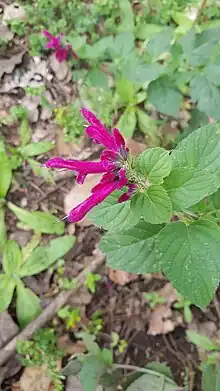| Salvia littae | |
|---|---|
 | |
| Scientific classification | |
| Kingdom: | Plantae |
| Clade: | Tracheophytes |
| Clade: | Angiosperms |
| Clade: | Eudicots |
| Clade: | Asterids |
| Order: | Lamiales |
| Family: | Lamiaceae |
| Genus: | Salvia |
| Species: | S. littae |
| Binomial name | |
| Salvia littae Visiani | |
Salvia littae is a herbaceous perennial native to the Mexican state of Oaxaca, growing at elevations of 8,000-10,000 feet. The plants typically grow in some shade in groups at the edge of moist oak forest, or cloud forest.[1]
Salvia littae grows 4–6 feet tall and up to 6 feet wide, forming thickets when left alone. The plant puts out many leafy stems which easily root when they touch the ground. The 1-3 inch medium-green leaves grow profusely on the plant, and are glabrous and rounded. Inflorescences reach up to 1 foot tall, with the flowers growing in tight verticils. The 1 inch flowers are a brilliant magenta, and covered with hairs. The upper lip is upright, and the lower lip is wide open. The two-part lower lip appears curled under, unusual in salvia plants. The small calyx is a bright lime-green, adding to the attractiveness of the flowers.[1]
Notes
- 1 2 Clebsch, Betsy; Barner, Carol D. (2003). The New Book of Salvias. Timber Press. p. 198. ISBN 978-0-88192-560-9.